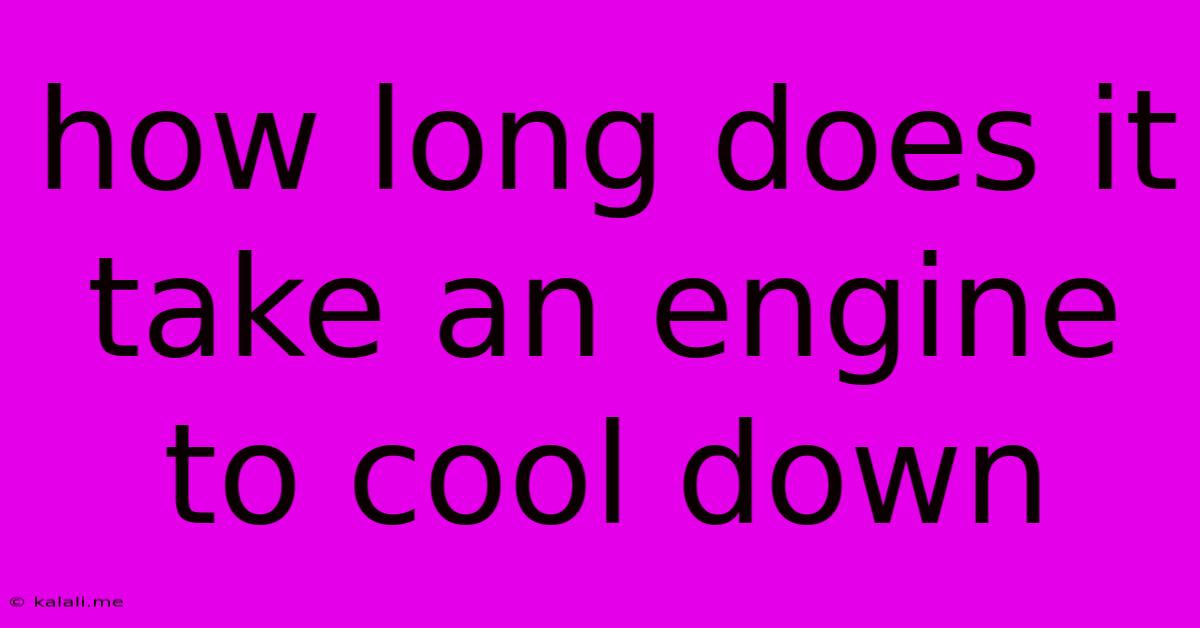How Long Does It Take An Engine To Cool Down
Kalali
Jun 07, 2025 · 3 min read

Table of Contents
How Long Does It Take an Engine to Cool Down? A Comprehensive Guide
Knowing how long it takes your engine to cool down is crucial for its longevity and your safety. This isn't just about avoiding burns; it's about preventing costly damage and ensuring optimal performance. This guide explores the factors influencing engine cool-down time, providing practical advice and safety tips.
Factors Affecting Engine Cool-Down Time
Several factors determine how long your engine needs to cool down before it's safe to work on or leave unattended. These include:
-
Engine Size and Type: Larger engines, such as those found in trucks or SUVs, generally take longer to cool down than smaller engines in compact cars. The type of engine (gasoline, diesel, etc.) also plays a role, with diesels often retaining heat longer due to their higher operating temperatures.
-
Ambient Temperature: On a hot day, your engine will take considerably longer to cool than on a cool day. High ambient temperatures slow down the heat dissipation process.
-
Driving Conditions: Hard driving, especially at high speeds or under heavy load, generates more heat and extends the cooling-down period. Conversely, gentle driving will result in faster cooling.
-
Cooling System Efficiency: A well-maintained cooling system, including a functioning radiator, thermostat, water pump, and coolant, will cool the engine more efficiently. A malfunctioning system significantly increases cool-down time.
-
Engine Oil: The engine oil itself retains heat, and its viscosity also impacts cooling. Thicker oil takes longer to cool.
How Long is "Long Enough"?
There's no single definitive answer to how long an engine needs to cool. A good rule of thumb is to allow at least 30 minutes for the engine to cool down before attempting any maintenance or repairs. This is especially important if you've been driving aggressively or in hot conditions. Touching the engine block after this time should reveal a significantly reduced temperature.
However, you should exercise caution even after 30 minutes, particularly around areas like the radiator and exhaust manifold which will retain heat for longer. Consider using insulated gloves for extra protection.
Signs Your Engine Needs More Time to Cool Down:
- Steaming: Visible steam indicates significant heat still radiating from the engine.
- Hot Touch: If the engine block or other components are too hot to touch comfortably, more cooling time is needed.
- Boiling Coolant: Never open the radiator cap if the coolant is boiling or visibly pressurised; this is extremely dangerous.
- Unusual Noises: Unusual sounds could indicate overheating damage. Let the engine cool completely before inspecting.
Safety Precautions:
- Never rush the cooling process. Patience is key to preventing burns and engine damage.
- Always use caution when working near a hot engine. Wear appropriate safety gear, including heat-resistant gloves and eye protection.
- Avoid touching hot surfaces. Radiator hoses, the exhaust manifold, and other components can remain extremely hot long after the engine has stopped.
- If you're unsure, wait longer. It's always better to err on the side of caution.
Conclusion:
While a 30-minute waiting period provides a general guideline, the actual cooling time varies significantly depending on several factors. Prioritizing safety and allowing ample time for your engine to cool down prevents burns, potential injuries, and costly repairs. Understanding these factors and following safety precautions ensures the longevity and optimal performance of your vehicle's engine.
Latest Posts
Latest Posts
-
Do Study Bibles Have All The Bible Verses
Jun 07, 2025
-
Can A Hot Water Heater Explode
Jun 07, 2025
-
How To Remove Pavers From A Walkway
Jun 07, 2025
-
On A Wall Power Brick Which Is Hot
Jun 07, 2025
-
How To Turn Off Imessage For One Person
Jun 07, 2025
Related Post
Thank you for visiting our website which covers about How Long Does It Take An Engine To Cool Down . We hope the information provided has been useful to you. Feel free to contact us if you have any questions or need further assistance. See you next time and don't miss to bookmark.